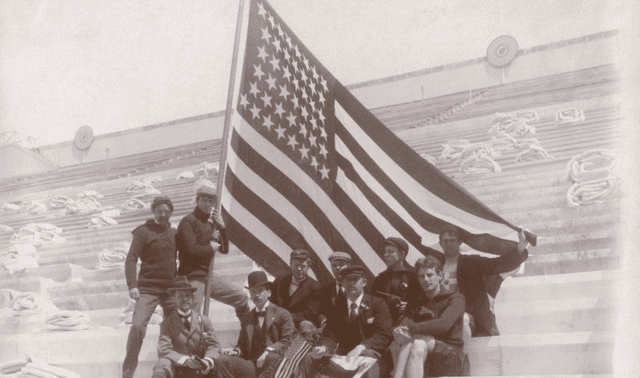Ordinarily in this space we celebrate anniversaries of advances that improved our ancestors’ lives. This time, however, we note an invention responsible for killing 100 million of our relatives in the 20th century alone: the commercially produced cigarette.
George Washington Duke is generally credited with inaugurating the commercial manufacture of cigarettes in Orange County, NC, 150 years ago, in 1865. His son James “Buck” Duke implemented the first successful use of a mechanical cigarette roller, which in turn enabled him to form the American Tobacco Co. in 1890.
The Dukes, of course, weren’t the first to light up. Drawings depict Native Americans smoking tobacco, apparently for religious and medicinal purposes, as early as 600 AD, and tobacco was the first cash crop of the colonists in Jamestown. By the 19th century, people smoked cigars and hand-rolled cigarettes, but only about 40 a year on average, according to Massachusetts’ Cambridge Tobacco Education Program.
When Washington Duke obtained 300 acres of land from his first wife’s father in 1847, he initially grew a mix of crops. Then the Civil War began and Duke, although a Union sympathizer, was conscripted into the Confederate Navy. He converted his full acreage to tobacco and rented the farm, with payment to be made in leaves. His brief stint as a sailor ended in a POW camp. Released in New Bern, NC, Duke walked 135 miles home, where in a small log building he began manufacturing cigarettes for the occupying Union soldiers.
Soon Duke was peddling his products into eastern North Carolina, transporting them with two blind mules and a creaky wagon. By 1866, production was up to 15,000 pounds of “Pro Bono Publico” tobacco and cigarettes.
But inefficient (not to mention unsanitary) rolling with hands and sealing with saliva limited the cigarette business.
In 1881—another epochal year in cigarette history—Duke’s son Buck ventured to New York to hire 125 immigrants from Eastern Europe, skilled in that region’s early cigarette-making industry, who could roll three or four per minute. The experts, on strike against one of Duke’s competitors, were lured to W. Duke and Sons Co., now based in Durham, NC. But their Tar Heel tenure would be brief.
Also in 1881, an 18-year-old Virginian named James Bonsack patented a cigarette-rolling machine that used a Rube Goldberg-esque complexity of gears, rollers and levers. “This general result has heretofore been attempted,” Bonsack wrote in his patent application, “but so far as I know with but little success.”
In fact, Bonsack’s initial invention wasn’t very successful, either. After a failed test in the Allen and Ginter cigarette factory in Richmond, the company discarded the machine.
The ever-enterprising Buck Duke gave it a second chance in 1884, installing two Bonsack machines in Durham that each could do the work of 48 hand rollers. Tinkering by Duke and engineer William “Tim” O’Brien ironed out the mechanical problems, and each machine began producing 120,000 cigarettes a day. “It cranked out what was essentially a cigarette of infinite length, cut into the appropriate lengths by whirling shears,” says Stanford University historian of technology Robert Proctor. Because of the open ends, additives such as glycerin, sugar and molasses were necessary to keep the cigarette from drying out.
The imported hand-rollers, understandably, weren’t happy about mechanization. O’Brien got death threats.
Employees joined the local Cigarmakers Progressive Union and later the Knights of Labor. But by 1888, Duke had replaced all human cigarette rollers with Bonsack machines. A letter in the Journal of United Labor complained that machinery “is the curse of the laborer” and criticized the ingratitude of those like Duke who “owes his mills and fortune to the cigarette makers who today are thrown out of employment.”
Now Duke had a new problem. He could make more cigarettes than he could sell: 120,000 cigarettes a day was about one-fifth of all US consumption. So he also became a pioneer in advertising, in 1889 alone spending the equivalent of $25 million in today’s money. The machine-made cigarettes were marketed as more modern and hygienic, suitable for places like restaurants, where pipes and cigars might be frowned upon.
Cigarettes also were a far more efficient mechanism for delivering nicotine and carcinogens: They carry smoke directly into the lungs, whose surfaces rapidly absorb nicotine into the bloodstream, where it reaches the brain seven seconds post-puff (twice as fast as injected heroin). But people thought cigarettes were safer than cigars, and pharmaceutical encyclopedias listed cigarettes as beneficial to health. Doctors prescribed them for coughs.
The Supreme Court broke up Duke’s American Tobacco Co. as a monopoly in 1911, but the four pieces the ruling created—a new American Tobacco, Liggett and Myers, P. Lorillard and R.J. Reynolds—went on to become giants on their own. US cigarette consumption had already quadrupled between 1890 and 1900. Sales boomed with the free marketing of two world wars, during which soldiers’ rations included cigarettes. Women on the home front, exercising their independence in the spirit of Rosie the Riveter, took up the habit, too. By 1944, annual cigarette production reached 300 billion.
Only in 1964 did the cigarette bandwagon Washington and Buck Duke began hit a serious bump: Surgeon General Luther Terry released the first report of his Advisory Committee on Smoking and Health. Based on more than 7,000 studies, the report concluded that cigarette smoking causes lung and laryngeal cancers, and was the most important cause of chronic bronchitis. In 1965—when US adult per capita consumption peaked at 4,295 cigarettes per year—Congress required a warning on every pack: “Cigarettes may be hazardous to your health.”
Demand for cigarettes in the United States has been declining ever since, though smoking in developing countries continues to increase. That, too, is a legacy of Buck Duke, who partnered with the United Kingdom’s Imperial Tobacco in 1902 to spread cigarettes worldwide under the British American Tobacco brand. “All of the globalization that we’re now familiar with through McDonald’s and Starbucks—all of that was preceded by Duke and the cigarette,” says Jordan Goodman, author of Tobacco in History.
He shared much of his tobacco fortune, donating more than $100 million to Durham’s Trinity College. It was renamed Duke University in 1924 to honor him and his father. But it’s hard to overlook the Dukes’ role in making the 20th century what some have called “the cigarette century.” Historian Proctor calls their product the deadliest artifact in the history of human civilization.
Fun Facts
- George Washington grew tobacco, and profits from tobacco farming helped fund the American Revolution.
- Cigarettes were prohibited in 16 states between 1890 and 1927, mostly for moral rather than health reasons.
- In the 1920s, the American Tobacco Co. hired Edward Bernays—the father of public relations—to persuade women it was acceptable to smoke cigarettes (“torches of freedom,” in his ad campaign).
- The owner of a paper cigarette-holder company invented the drinking straw in the 1880s, applying some of his know-how to a replacement for the natural rye grass used at the time.
Timeline
1612 | Jamestown settlers plant tobacco
1865 | Washington Duke begins cigarette production
1881 | James Bonsack patents cigarette-rolling machine
1889 | Duke Tobacco Co. spends $800,000 on cigarette marketing, including baseball cards in each pack
1890 | Leading tobacco companies merge to form American Tobacco Co.
1911 | Supreme Court breaks up American Tobacco Co.
1919 | Americans smoke more than 10 billion cigarettes
1954 | “Marlboro Man” debuts
1964 | Surgeon General’s report links smoking to cancer and bronchitis
1865 | Washington Duke begins cigarette production
1881 | James Bonsack patents cigarette-rolling machine
1889 | Duke Tobacco Co. spends $800,000 on cigarette marketing, including baseball cards in each pack
1890 | Leading tobacco companies merge to form American Tobacco Co.
1911 | Supreme Court breaks up American Tobacco Co.
1919 | Americans smoke more than 10 billion cigarettes
1954 | “Marlboro Man” debuts
1964 | Surgeon General’s report links smoking to cancer and bronchitis
From the January/February 2015 Family Tree Magazine




